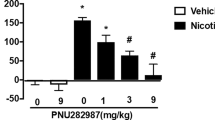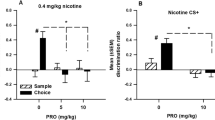Abstract
Nicotine addiction is a chronic disorder characterized by a relatively high rate of relapse even after long period of abstinence. In the present study, we used the conditioned place preference (CPP) paradigm to investigate the establishment, extinction, reinstatement, and cross-reinstatement of nicotine-induced place conditioning in rats. First, we revealed that nicotine produced a place preference to the initially less-preferred compartment paired with its injections during conditioning (0.175 mg/kg, base, intraperitoneally (i.p.)). Once established, nicotine CPP was extinguished by repeated testing. Following this extinction phase, nicotine-experienced rats were challenged with nicotine (0.175 mg/kg, i.p.) or morphine (10 mg/kg, i.p.). These priming injections of both drugs induced a marked preference for the compartment previously paired with nicotine. Furthermore, given the important role of alpha4beta2 (a4b2) nicotinic receptor subtype in the acquisition and maintenance of nicotine dependence, we evaluated and compared the efficacy of varenicline, a partial a4b2 nicotinic receptor agonist (0.5, 1, and 2 mg/kg, subcutaneously (s.c.)), and mecamylamine (0.5, 1, and 2 mg/kg, s.c.), a non-selective nicotinic receptor antagonist, in blocking nicotine-induced CPP as well as reinstatement of nicotine CPP provoked by nicotine and morphine. It was shown that both nicotinic receptor ligands attenuated the acquisition and expression of nicotine CPP as well as the expression of reinstatement of nicotine CPP provoked by both drugs. Our results indicate similar cholinergic mechanisms, probably through the a4b2 receptors involved in the rewarding effects of nicotine and morphine in rats and may suggest that nicotinic receptors could be a potential target for developing pharmacotherapeutic strategies to treat and prevent nicotine and/or opioid addiction and relapse.







Similar content being viewed by others
References
Almeida LE, Pereira EF, Alkondon M, Fawcett WP, Randall WR, Albuquerque EX (2000) The opioid antagonist naltrexone inhibits activity and alters expression of alpha7 and alpha4beta2 nicotinic receptors in hippocampal neurons: implications for smoking cessation programs. Neuropharmacology 39:2740–2755
Balfour DJ (2002) Neuroplasticity within the mesoaccumbens dopamine system and its role in tobacco dependence. Curr Drug Targets CNS Neurol Disord 1:413–421
Berrendero F, Kieffer BL, Maldonado R (2002) Attenuation of nicotine-induced antinociception, rewarding effects, and dependence in μ-opioid receptor knock-out mice. J Neurosci 22:10935–10940
Biala G (2003) Calcium channel antagonists suppress nicotine-induced place preference and locomotor sensitization in rodents. Pol J Pharmacol 55:327–335
Biala G, Budzynska B (2006) Reinstatement of nicotine-conditioned place preference by drug priming: effects of calcium channel antagonists. Eur J Pharmacol 537:85–93
Biala G, Weglinska B (2006) On the mechanism of cross-tolerance between morphine- and nicotine-induced antinociception: involvement of calcium channels. Prog Neuropsychopharmacol Biol Psychiatry 30:15–21
Biala G, Budzynska B (2008) Calcium-dependent mechanisms of the reinstatement of nicotine-conditioned place preference by drug priming in rats. Pharmacol Biochem Behav 89:116–125
Biala G, Budzynska B, Kruk M (2005) Naloxone precipitates nicotine abstinence syndrome and attenuates nicotine-induced antinociception in mice. Pharmacol Rep 57:755–760
Calcagnetti DJ, Schechter MD (1994) Nicotine place preference using the biased method of conditioning. Prog Neuropsychopharmacol Biol Psychiatry 18:925–933
Carr GD, Fibiger HC, Phillips AG (1989) Conditioned place preference as a measure of drug reward. In: Liebman JM, Cooper SJ (eds) The neuropharmacological basis of reward. Oxford University Press, Oxford, pp 264–319
Chaudhri N, Caggiula AR, Donny EC, Booth S, Gharib M, Craven L et al (2006) Operant responding for conditioned and unconditioned reinforcers in rats is differentially enhanced by the primary reinforcing and reinforcement-enhancing effects of nicotine. Psychopharmacology 189:27–36
Coe JW, Brooks PR, Vetelino MG, Wirtz MC, Arnold EP, Huang J et al (2005) Varenicline: an α4β2 nicotinic receptor partial agonist for smoking cessation. J Med Chem 48:3474–3477
Cohen C, Bergis OE, Galli F, Lochead AW, Jegham S, Biton B et al (2003) SSR591813, a novel and selective partial a4b2 nicotinic receptor with potential as an aid for smoking cessation. J Pharmacol Exp Ther 306:407–420
Corrigall WA, Franklin KB, Coen KM, Clarke PB (1992) The mesolimbic dopaminergic system is implicated in the reinforcing effects of nicotine. Psychopharmacology 107:285–289
Dani JA, Ji D, Zhou FM (2001) Synaptic plasticity and nicotine addiction. Neuron 31:349–352
Donny EC, Caggiula AR, Mielke MM, Booth S, Gharib MA, Hoffman A et al (1999) Nicotine self-administration in rats on a progressive ratio schedule of reinforcement. Psychopharmacology (Berl) 147:135–142
Ericson M, Löf E, Stomberg R, Söderpalm B (2009) The smoking cessation medication varenicline attenuates alcohol and nicotine interactions in the rats mesolimbic dopamine system. JPET 329:225–230
Fiserova M, Consolo S, Krsiak M (1999) Chronic morphine induces long-lasting changes in acetylcholine release in rat nucleus accumbens core and shell: an in vivo microdialysis study. Psychopharmacology 142:85–94
Gotti C, Clementi F (2004) Neuronal nicotinic receptors: from structure to pathology. Prog Neurobiol 74:363–396
Gronier B, Perry KW, Rasmussen K (2000) Activation of the mesocorticolimbic dopaminergic system by stimulation of muscarinic cholinergic receptors in the ventral tegmental area. Psychopharmacology 147:347–355
Hughes JR (2007) Effects of abstinence from tobacco: valid symptoms and time course. Nicotine Tob Res 9:315–327
Kelley AE (2002) Nicotinic receptors: addiction’s smoking gun? Nat Med 8:447–449
Kenford SL, Fiore MC, Jorenby DE, Smith SS, Wetter D, Baker TB (1994) Predicting smoking cessation. Who will quit with and without the nicotine patch. JAMA 271:589–594
Mansvelder HD, Keath JR, McGehee DS (2002) Synaptic mechanisms underlie nicotine-induced excitability of brain reward areas. Neuron 33:905–919
Marks MJ, Pauly JR, Gross SD, Deneris ES, Hermans-Borgmeyer I, Heinemann SF, Collins AC (1992) Nicotine binding and nicotinic receptor subunit RNA after chronic nicotine treatment. J Neurosci 12:2765–2784
Marubio LM, Gardier AM, Durier S, David D, Klink R, Arroyo-Jimenez MM et al (2003) Effects of nicotine in the dopaminergic system of mice lacking the alpha 4 subunit of neuronal nicotinic acetylcholine receptors. Eur J Neurosci 17:1327–1337
Maskos U, Molles BE, Pons S, Besson M, Guiard BP, Guilloux J-P et al (2005) Nicotine reinforcement and cognition restored by targeted expression of nicotinic receptors. Nature 436:103–107
Miller AD, Forster GL, Yeomans JS, Blaha CD (2005) Midbrain muscarinic receptors modulate morphine-induced accumbal and striatal dopamine efflux in the rat. Neuroscience 136:531–538
Picciotto MR, Zoli M, Rimondini R, Lena C, Marubio LM, Merlo-Pich E et al (1998) Acetylcholine receptors containing the beta-2 subunit are involved in the reinforcing properties of nicotine. Nature 391:173–177
Potts LA, Garwood CL (2007) Varenicline: the newest agent for smoking cessation. Am J Health-Syst Pharm 64:1381–1384
Rahman S, Neugebauer NM, Zhang Z, Crooks PA, Dwoskin LP, Bardo MT (2007) The effects of a novel nicotinic receptor antagonist N, Ndodecane-1, 12-diyl-bis-3-picolinium dibromide (bPiDDB) on acute and repeated nicotine-induced increases in extracellular dopamine in rat nucleus accumbens. Neuropharmacology 52:755–763
Reid MS, Fox L, Ho LB, Berger SP (2000) Nicotine stimulation of extracellular glutamate levels in the nucleus accumbens: neuropharmacological characterization. Synapse 35:129–136
Rezayof A, Nazari-Serenjeh F, Zarrindast MR, Sepehri H, Delphi L (2007) Morphine-induced place preference: involvement of cholinergic receptors of the ventral tegmental area. Eur J Pharmacol 562:92–102
Rollema H, Coe JW, Chambers LK, Hurst RS, Stahl SM, Williams KE (2007a) Rationale, pharmacology and clinical efficacy of partial agonists of α4β2 nACh receptors for smoking cessation. Trends Pharmacol Sci 28:316–325
Rollema H, Chambers LK, Coe JW, Glowa J, Hurst RS, Lebel LA et al (2007b) Pharmacological profile of the alpha4beta2 nicotinic acetylcholine receptor partial agonist varenicline, an effective smoking cessation aid. Neuropharmacology 52:985–994
Stapleton JA, Watson L, Spirling LI, Smith R, Milbrandt A, Ratcliffe M, Sutherland G (2008) Varenicline in the routine treatment of tobacco dependence: a pre-post comparison with nicotine replacement therapy and an evaluation in those with mental illness. Addiction 103:146–154
Taguchi K, Hagiwara Y, Suzuki Y, Kubo T (1993) Effects of morphine on release of acetylcholine in the rat striatum: an in vivo microdialysis study. Naunyn Schmiedebergs Arch Pharmacol 347:9–13
Tome AR, Izaguirre V, Rosario LM, Cena V, Gonzales-Garcia G (2001) Naloxone inhibits nicotine-induced receptor current and catecholamine secretion in bovine chromaffin cells. Brain Res 903:62–65
Tonstad S, Tønnesen P, Hajek P, Williams KE, Billing CB, Reeves KR (2006) Varenicline Phase 3 Study Group. Effect of establishment therapy with varenicline on smoking cessation: a randomized controlled trial. JAMA 296:64–71
Tzschentke TM (1998) Measuring reward with the conditioned place preference paradigm: a comparative review of drug effects, recent progress and new issues. Prog Neurobiol 56:613–672
Watkins SS, Epping-Jordan MP, Koob GF, Markou A (1999) Blockade of nicotine self-administration with nicotinic antagonists in rats. Pharmacol Biochem Behav 62:743–751
West R, Ussher M, Evans M, Rashid M (2006) Assessing DSM-IV nicotine withdrawal symptoms: a comparison and evaluation of five different scales. Psychopharmacology 184:619–627
Wonnacott S (1997) Presynaptic nicotinic ACh receptors. Trends Neurosci 20:92–98
Wonnacott S, Sidhpura N, Balfour DJ (1997) Nicotine: from molecular mechanisms to behaviour. Curr Opin Pharmacol 5:53–59
Wooltorton JR, Pidoplichko VI, Broide RS, Dani JA (2003) Differential desensitization and distribution of nicotinic acetylcholine receptor subtypes in midbrain dopamine areas. J Neurosci 23:3176–3185
Yeomans J, Baptista M (1997) Both nicotinic and muscarinic receptors in ventral tegmental area contribute to brain-stimulation reward. Pharmacol Biochem Behav 57:915–921
Yeomans J, Mathur A, Tampakeras M (1993) Rewarding brain stimulation: role of tegmental cholinergic neurons that activate dopamine neurons. Behav Neurosci 107:1077–1087
Zarrindast MR, Khoshayand MR, Shafaghi B (1999) The development of cross-tolerance between morphine and nicotine in mice. Eur Neuropsychopharmacol 9:227–233
Acknowledgement
The authors would like to thank Pfizer Inc. (Groton, USA) for the generous gift of varenicline. This work was supported by the Statutory Funds of the Medical University of Lublin (DS 23/09) and received no special grant from any funding agency in the public, commercial, or not-for-profit sectors. All authors declare that they have no conflict of interest to disclose.
Author information
Authors and Affiliations
Corresponding author
Rights and permissions
About this article
Cite this article
Biala, G., Staniak, N. & Budzynska, B. Effects of varenicline and mecamylamine on the acquisition, expression, and reinstatement of nicotine-conditioned place preference by drug priming in rats. Naunyn-Schmied Arch Pharmacol 381, 361–370 (2010). https://doi.org/10.1007/s00210-010-0498-5
Received:
Accepted:
Published:
Issue Date:
DOI: https://doi.org/10.1007/s00210-010-0498-5




